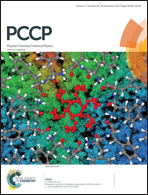High resolution absolute absorption cross sections of the ![[B with combining tilde]](https://www.rsc.org/images/entities/char_0042_0303.gif) 1A′–
1A′–![[X with combining tilde]](https://www.rsc.org/images/entities/char_0058_0303.gif) 1A′ transition of the CH2OO biradical†
1A′ transition of the CH2OO biradical†
Abstract
Carbonyl oxides, or Criegee intermediates, are formed from the gas phase ozonolysis of alkenes and play a pivotal role in night-time and urban area atmospheric chemistry. Significant discrepancies exist among measurements of the strong ![[B with combining tilde]](https://www.rsc.org/images/entities/char_0042_0303.gif) 1A′–
1A′–![[X with combining tilde]](https://www.rsc.org/images/entities/char_0058_0303.gif) 1A′ electronic transition of the simplest Criegee intermediate, CH2OO in the visible/near-UV. We report room temperature spectra of the
1A′ electronic transition of the simplest Criegee intermediate, CH2OO in the visible/near-UV. We report room temperature spectra of the ![[B with combining tilde]](https://www.rsc.org/images/entities/char_0042_0303.gif) 1A′–
1A′–![[X with combining tilde]](https://www.rsc.org/images/entities/char_0058_0303.gif) 1A′ electronic absorption band of CH2OO acquired at higher resolution using both single-pass broadband absorption and cavity ring-down spectroscopy. The new absorption spectra confirm the vibrational structure on the red edge of the band that is absent from ionization depletion measurements. The absolute absorption cross sections over the 362–470 nm range are in good agreement with those reported by Ting et al. Broadband absorption spectra recorded over the temperature range of 276–357 K were identical within their mutual uncertainties, confirming that the vibrational structure is not due to hot bands.
1A′ electronic absorption band of CH2OO acquired at higher resolution using both single-pass broadband absorption and cavity ring-down spectroscopy. The new absorption spectra confirm the vibrational structure on the red edge of the band that is absent from ionization depletion measurements. The absolute absorption cross sections over the 362–470 nm range are in good agreement with those reported by Ting et al. Broadband absorption spectra recorded over the temperature range of 276–357 K were identical within their mutual uncertainties, confirming that the vibrational structure is not due to hot bands.
![Graphical abstract: High resolution absolute absorption cross sections of the [[B with combining tilde]] 1A′– [[X with combining tilde]] 1A′ transition of the CH2OO biradical](/en/Image/Get?imageInfo.ImageType=GA&imageInfo.ImageIdentifier.ManuscriptID=C5CP04977F&imageInfo.ImageIdentifier.Year=2015)

 Please wait while we load your content...
Please wait while we load your content...
![[B with combining tilde]](https://www.rsc.org/images/entities/h2_char_0042_0303.gif) 1A′–
1A′–![[X with combining tilde]](https://www.rsc.org/images/entities/h2_char_0058_0303.gif) 1A′ transition of the CH2OO biradical
1A′ transition of the CH2OO biradical